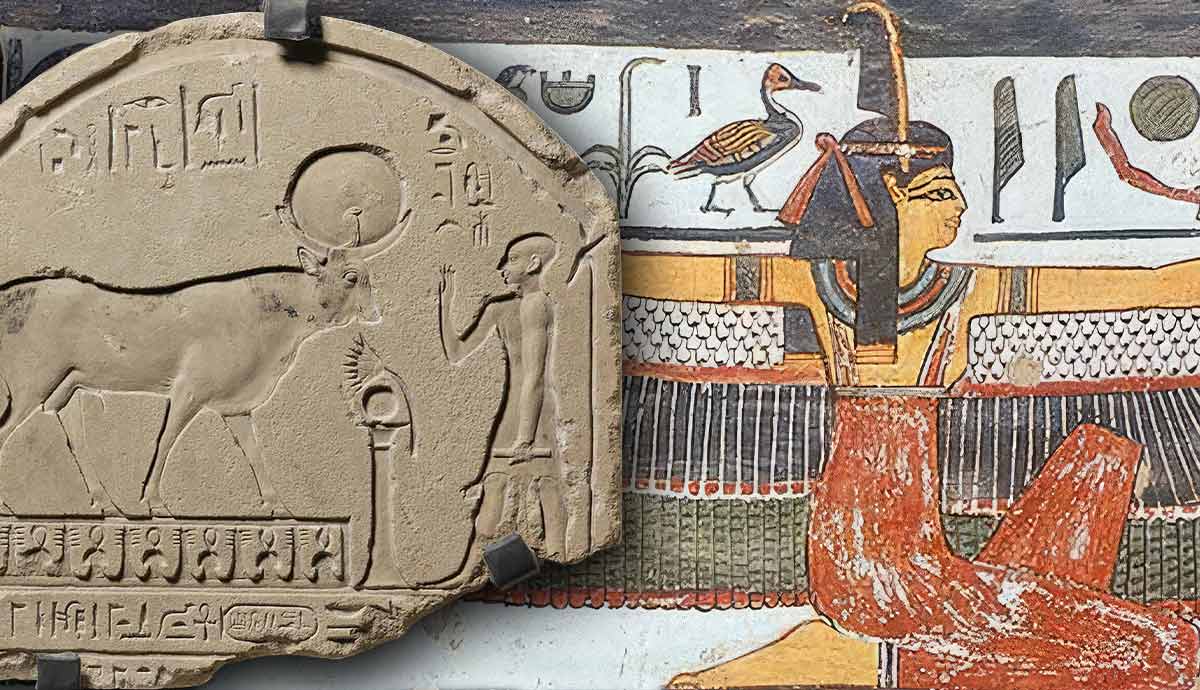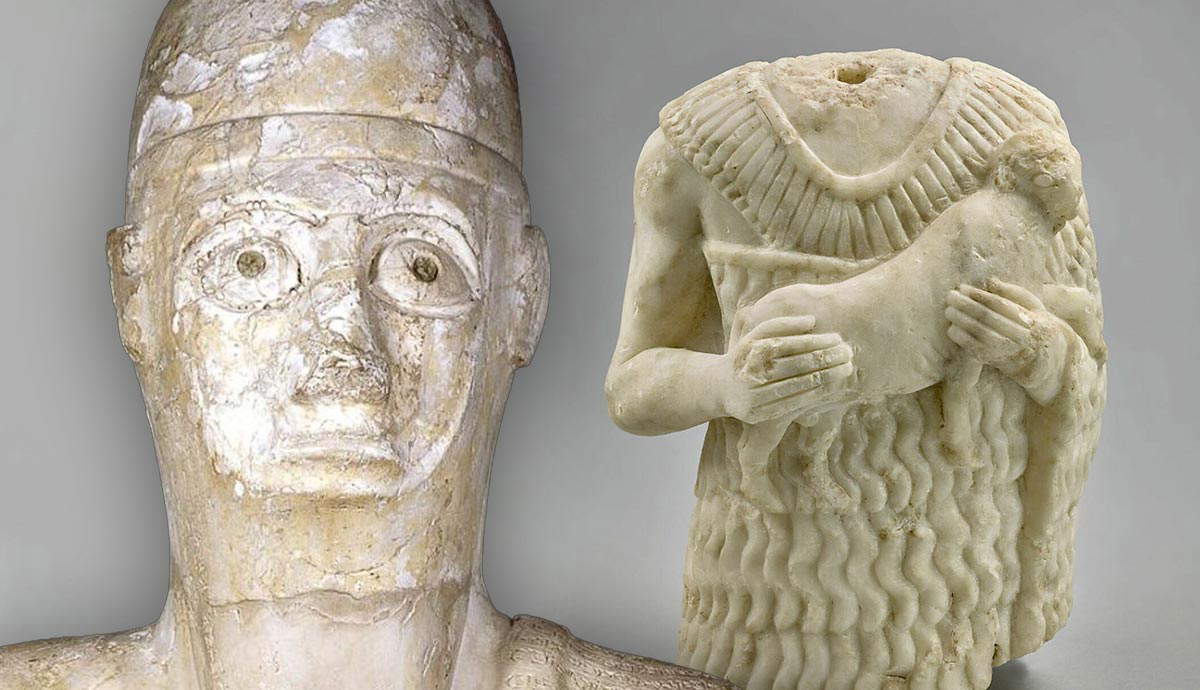
Since the dawn of time, humans have developed numerous religions in their quest to commune with god. The ancient Egyptians were no different in this respect, but most of what is known about Egyptian religion concerns monumental elements, such as the temples and pyramids. In the shadows of those pyramids and temples, everyday Egyptian commoners practiced a religion known today as “popular religion.” Thanks to a combination of textual sources and archaeological artifacts, modern scholars have gained unique insights into how non-royal Egyptians practiced their religion.
The Basics of the Ancient Egyptian Religion

Before examining how the ancient Egyptians practiced everyday religion, it is important to understand some basic theological ideas. The Egyptian religion was polytheistic. Specific gods and goddesses had their followings centered in specific localities. To interact with their gods and goddesses, the adherents of specific deities had to follow specific rituals, which modern Egyptologists have termed “cult” or “cultic.” The term cult is also used to refer to the following of each Egyptian deity. Although all the major ancient Egyptian deities had specific rituals that their followers were expected to perform, the Egyptian religion had unifying concepts, the most important of which was Maat.

Maat was the ancient Egyptian word for “order,” which was a vital part of all elements of Egyptian society. The concept of order played such an integral role in Egyptian religion that it was even personified in the form of a goddess also named Maat. Of course, the opposite of order was chaos, which happened when the gods were not worshipped with the proper rituals. Therefore, all Egyptians, regardless of class, were expected to play their part in maintaining the order of the world. For Egyptian royals, this meant commissioning the construction of temples and donating ornate votive offerings to religious cults. Because everyday Egyptians did not have the resources to perform such ostentatious displays of piety, they eventually developed a unique form of popular religion.
The Concept of Popular or Everyday Religion

Popular religion, or everyday religion in Egypt, refers to the religious practices of the people that were conducted outside of the official state cults and temples. Although popular religion is often associated with the non-royals, it includes all classes and denotes how individuals privately communed with the gods. The methods by which this was done reflected the official religion in many ways, with rituals taking precedence over morality or ideology. And foremost among the rituals everyday Egyptians did was votive offerings.
Votive offerings left in temples came in many forms beginning in the Early Dynastic Period (early third millennium BCE), with most being donated by elites. There is little extant textual or archaeological evidence of the everyday religious practices of the commoners until the New Kingdom (c. 1550 BCE). Many extant examples of popular religion from this period come from the workmen’s village in Deir el-Medina. The tomb workers there donated votive stelae and even built altars to the gods in their homes as a sign of piety. As the New Kingdom progressed, popular religion among commoners gained momentum until it became fully realized in the Late Period (664-332 BCE) in what some Egyptologists have called the “democratization of the afterlife.” From the Late Period through the rule of the Greeks and Romans, there is plenty of primary source evidence documenting everyday Egyptian religious practices.
Votive Offerings

The most common votive offerings were stelae and statues, which were donated to the temple of a particular deity. Stelae were small stone slabs that were usually inscribed with a standard formula and sometimes a short biographical inscription. Because skilled and literate workmen were required to make stelae, donating one to a temple was a symbol of sacrifice and piety. Although the majority of the extant stelae that are in museums today were donated by elites, commoners also donated a fair share. Also, as the democratization of Egyptian religion progressed in the Late Period, more women participated in cultic functions by donating votive stelae to temples.
One particularly interesting votive stela was donated by a woman named Isenkhebe. It recalls how despite a difficult childhood she remained faithful to the gods:
“O King of Gods, lord of eternity, to whom all people come! Give me bread, milk, incense, water that come from your altar, I am a young girl without fault!”
Votive stelae were an economical way for one to commune with the gods, but if one had more resources then votive statues were preferred. Votive statues were small statues — usually no more than a foot high — that depicted the owner/donator. As with votive stelae, votive statues featured inscriptions with similar religious formulae: identification of the deities to whom the statue was dedicated, and almost always a brief biography.
Among the more historically important votive statues was one dedicated by a physician named Udjahorresent. The text indicates that the statue was originally donated in the sixth century BCE by Udjahorresent to the temple of the goddess Neith in Sais. The religious aspect of the text is interesting, but the biographical inscription gives a fascinating glimpse into how Egyptians reacted to foreign rule. The text relates how Udjahorresent served as an admiral under the Egyptian King Psamtek III (ruled 526-525 BCE), but then served as the Persian King Cambyses’ (ruled Egypt 525-530 BCE) assistant.
Popular Worship of the Apis Bull

Many of the ancient Egyptians gods and goddesses were depicted in art and texts as either hybrid human animals or anthropomorphic animals. From the earliest part of Egyptian history, the animal cults played a crucial role in the religion, although they evolved with time. The priests viewed only certain animals as sacred, while the people saw all animals of a specific species as sacred. This became more pronounced in the Late Period, especially during the rule of the Greeks and Romans. The dichotomy between official and popular patronage of the animal cults was most clearly demonstrated in the sacred necropolis region of Saqqara.
The Saqqara region was home to Old Kingdom monuments such as the Step Pyramid of Djoser as well as tombs from all periods. But not all of those tombs housed human remains. Tens of thousands of mummified sacred animals were also interred throughout Saqqara, the most important being the Apis Bull. The Apis Bull was a living, sacred bull that according to the fifth-century BCE Greek historian, Herodotus, had very distinct markings. Herodotus described it as “black, with a white diamond on its forehead, the image of an eagle on his back, the hairs on its tail double, and a scarab under its tongue.” There was only one of these unique bulls at a time and amazingly there was always one living.
The Apis cult probably began in the First Dynasty (c. 3000-2890 BCE), but it did not become widely popular until the Eighteenth Dynasty (1550-1295 BC). It was in the Eighteenth Dynasty when the tomb complex of the mummified Apis bulls, known as the Serapeum, was first built. The Apis bulls were mummified the same way as humans and then interred in the Serapeum. Private individuals began donating votive stelae to the Serapeum after it opened and by the Twenty-Sixth Dynasty the Apis cult had become the focal point of popular religion in Egypt. Egyptologists have discovered more than 1,000 votive stelae in the Serapeum that were donated by Egyptians from all walks of life.
Other Popular Animal Cults in Ancient Egypt

The Serapeum may have been the most popular animal cult, but there were others located near it that were also popular and significant. Just north of the Serapeum, thousands of mummified falcons, ibises, and baboons were donated in open, public rituals. To the east of the Serapeum was the Anubion, which was a necropolis dedicated to the jackal-headed god of mummification, Anubis. Here mummified jackals and dogs were donated, but what would ancient Egyptian religion be without sacred cats? Every day Egyptians could show their reverence for Bastet, the cat-goddess of the home, by mummifying and donating their feline friends as votive offerings to the Bubasteion. Archaeologists have uncovered thousands of cat mummies in the Bubastieon, revealing a couple of interesting facts in the process. Some of the cat mummies were actually fakes that were comprised of other animal parts as well as non-biological debris. Perhaps most interesting is that some of the feline mummies appeared to have been killed specifically for burial, raising questions about personal piety.
All of this religious activity in Saqqara eventually made it an ancient destination spot by the fourth century BCE. Egyptian religious pilgrims of all classes traveled from as far north as Sais and from Elephantine in the south to donate votive offerings in Saqqara. The population of the Saqqara necropolis could swell at any time, especially during religious festivals, leading to the creation of a religious based economy. When pilgrims arrived in Saqqara they were met with merchants who sold their wares, which no doubt included animal mummies ready to be donated.
Imhotep Worship

The final aspect of everyday religion to discuss involved the deification of the man many consider to be the world’s first scientist. Imhotep was the vizier (chief administrator) of King Djoser (ruled c. 2667-2648 BCE). In addition to helping Djoser run the day-to-day affairs of Egypt, he was a high-priest, physician, and architect. Imhotep is credited with the creation of Djoser’s Step Pyramid, but it was his skills as a doctor that earned his immortal status. This is quite incredible because only kings and queens were usually the only mortals deified in ancient Egypt.
About 100 years after Imhotep died, he became a legend and by the Nineteenth Dynasty of the New Kingdom Egyptians began worshipping him. As with the other forms of popular religion, Imhotep worship became popular with everyday Egyptians in the Late Period. Imhotep was worshipped as the son of the creator god, Ptah, with his cult centers located in Saqqara and Philae. He was also associated with the ibis-headed god of wisdom Thoth. This connection influenced his followers to donate mummified ibises to the Saqqara necropolis. Ill pilgrims would also sleep in the public sections of his temples hoping for a cure or receiving good omens in their dreams.










